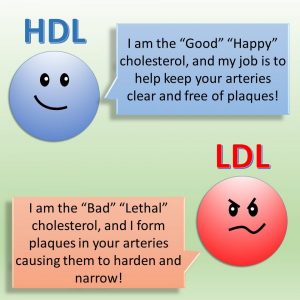
Table of Contents
Before knowing about differences between HDL and LDL, let us know, What is Cholesterol?
- Cholesterol is the fat like substance present in our body.
- Cholesterol is important in making cell membranes, hormones, Vitamin D etc.
- Cholesterol are also necessary to produce bile acids, which help the body digest fat and absorb important nutrients.
- Liver and intestine produce 80% of cholesterol and remaining 20% is obtained from food
- As cholesterol cannot mix with water and cannot move freely in the blood, it gets attached to the protein, making a complex called lipoproteins. Lipoproteins are made up of fats and proteins. There are two main forms of lipoprotein; -LDL and HDL

Some major differences between LDL and HDL are:
LDL |
HDL |
| LDL stands for Low Density Lipoprotein | HDL stands for High Density Lipoprotein |
| Also known as BAD CHOLESTEROL, because it transports cholesterol to our arteries, where it may accumulate in the artery walls | Also known as GOOD CHOLESTEROL, because it transports cholesterol to our liver so that the cholesterol can be expelled out from the body |
| Size is 18- 25 nm | Size is 5- 12 nm |
| Approximately 50 percent of the weight of an LDL particle is cholesterol and only 25 percent is protein | High-density lipoprotein particles, on the other hand, consist of 20 percent cholesterol by weight and 50 percent protein |
| Low-density lipoproteins contain proteins called B-100 proteins | HDL particles contain mostly A-I and A-II proteins. |
| Density of LDL:1.019- 1.063. It is relatively less dense than HDL | Density of HDL is: 1.063-1.210. It is relatively denser than LDL |
| They deliver cholesterol to tissue | They deliver cholesterol from blood and deposit to liver |
| Higher amounts of LDL leaves cholesterol to artery walls causing atherosclerosis
|
Higher amounts of HDL is important as it lowers the risk of cardiovascular disease |
| LDL particles are considered to be more pro-atherogenic | HDL are be anti-atherogenic |
| LDL particles are more susceptible to oxidation | HDL particles have anti-oxidant, anti-inflammatory, anti-thrombotic, and anti-apoptotic properties |
To help lower LDL levels:
|
HDL should be as high as possible. It is often possible to raise HDL by:
|
References and for more information:
https://www.health.harvard.edu/heart-health/how-its-made-cholesterol-production-in-your-body
https://www.betterhealth.vic.gov.au/health/conditionsandtreatments/cholesterol
https://heartuk.org.uk/health-and-high-cholesterol
https://www.healthdirect.gov.au/what-is-cholesterol
https://www.cdc.gov/cholesterol/ldl_hdl.htm
https://www.raydel.com.au/cholesterol-difference-hdl-ldl/
https://www.healthline.com/health/hdl-vs-ldl-cholesterol#diagnosis
https://www.ncbi.nlm.nih.gov/books/NBK351/
https://www.ncbi.nlm.nih.gov/books/NBK305896/
https://healthyeating.sfgate.com/ldl-hdl-differ-structurally-functionally-2003.html
https://www.healthline.com/health/hdl-vs-ldl-cholesterol#hdl-vs-ldl